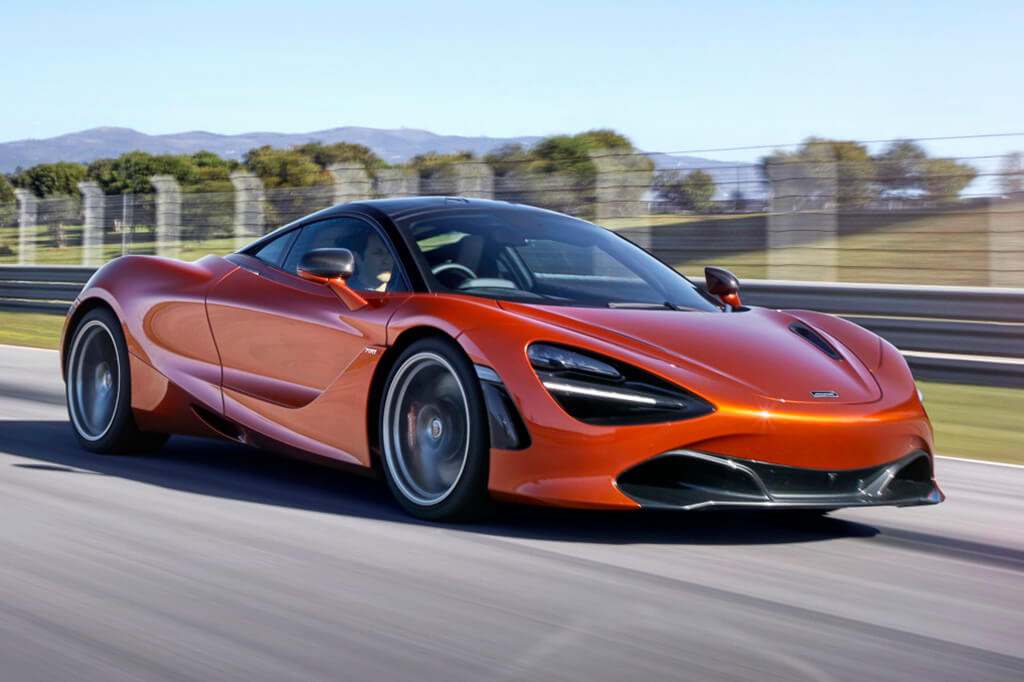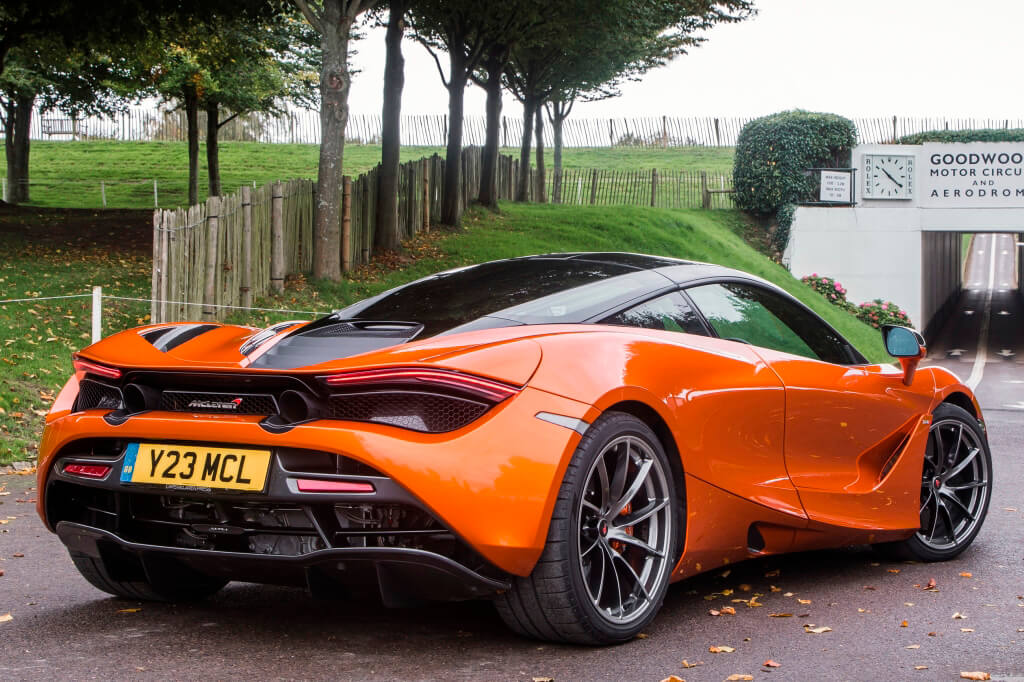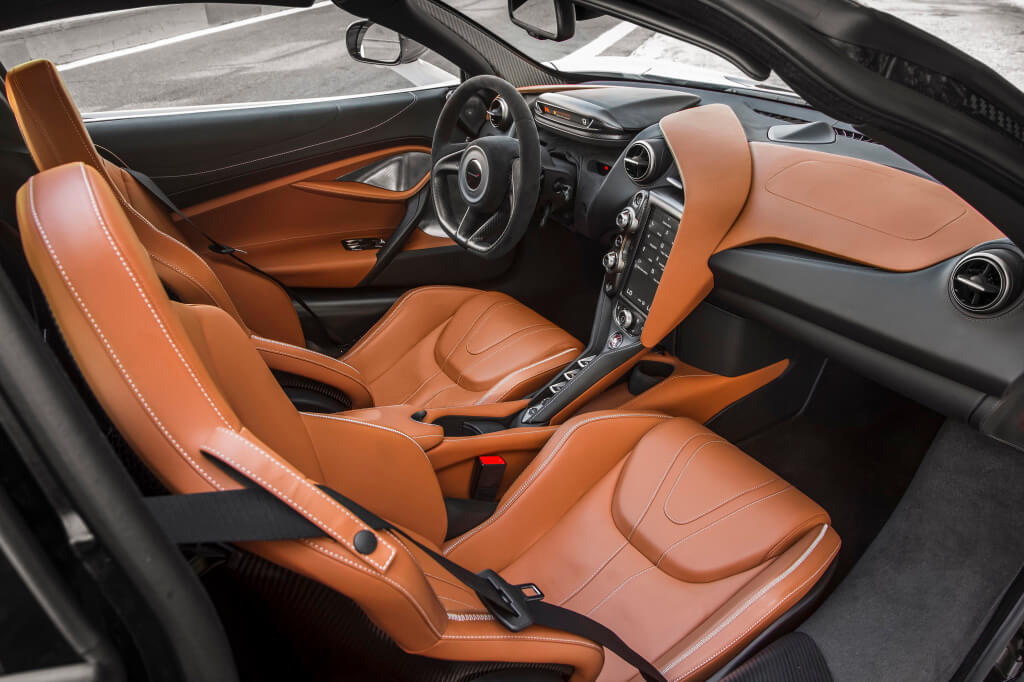McLaren 720S Coupe
Description
The McLaren 720S Coupe is a 2-seater sports car with butterfly wing doors.
Development and production
In just seven years of its existence as an automobile manufacturer, McLaren Automotive has expanded its lineup to three series (Sports, Super and Ultimate) and managed to change three generations of supercars. Its first product was the McLaren MP4-12C, in 2014 it was replaced by the McLaren 650S, and in March 2017, the McLaren 720S, a new member of the Super Series family, debuted at the 87th Geneva Motor Show. In May 2017, the supercar went to dealers at a price of 247,350 euros.
The car was also a two-seat, rear-wheel-drive, longitudinal-engined supercar that was built on a modified carbon-fiber chassis that was lighter and stiffer than its predecessor. According to the manufacturer, the supercar was 91% new.
Facts
The Lego company at the Goodwood Festival of Speed in June 2017 presented a full-size replica of the McLaren 720S. Six McLaren and Lego employees assembled around 280,000 terminal blocks in about 2,000 hours. The Lego model weighed 1.6 tons, about 300 kg more than the production car.
Engine
The 720S was powered by the new McLaren M840T 4-litre flat-crank twin-turbocharged engine, which was an evolution of the 3.8-litre M838T engine (41% new) used in the 650S. The increase in engine volume was due to an increase in the piston stroke by 3.6 mm. Power increased to 720 hp. at 7500 rpm, which gave the car its name, and the maximum torque was 770 N∙m at 5500 rpm.
Transmission
The engine was mated to a 7-speed dual-clutch automatic transmission that sent power to the rear wheels.
Chassis
The McLaren 720S was built around an improved Monocage II carbon fiber monocoque with front and rear aluminum subframes that was even lighter and stiffer than the McLaren 650S (18kg lighter). This design resulted in a 3 percent lower center of gravity and a dry weight of 1,283 kg – more than 135 kg lighter than the Ferrari 488 GTB. The monocoque had dihedral doors with large cutouts to facilitate entry and exit. It also reduced the size of the roof pillars, improving visibility for the driver. The same monocoque was used in the Senna, Speedtail and Elva sports cars.
The ProActive Chassis Control II active suspension system and Variable Drift Mode stability control used in the 720S was an evolution of the systems used in the 650S, but was 16kg lighter than previous versions. The new active suspension system was equipped with accelerometers at the top and pressure sensors at the bottom of the shock absorbers to accurately communicate real-time road conditions to the vehicle's on-board computer for optimal suspension settings. The system used the results of a doctoral dissertation from the University of Cambridge, which was developed over five years.
Brake system
The carbon-ceramic brake system had 6-piston calipers at the front and 4-piston at the rear. The rims were shod with Pirelli P-Zero Corsa tires measuring 245/35 R19 at the front and 245/35 R19 at the rear.
Exterior
The design of the supercar was developed under the guidance of the new chief designer of McLaren, Robert Melville. The sloping nose and wavy lines of the wings made it look like a great white shark, and the fully glazed, teardrop-shaped cockpit was reminiscent of a jet fighter's canopy or a computer mouse. "Double-deck" LED headlights were located in triangular recesses along with grilles to cool small radiators in front of the wheels. There were no side air intakes: they were replaced by hidden air channels in dihedral doors that open according to the “butterfly wing” principle. At the rear, the car featured thin LED taillights, two round exhaust pipes and an integrated active wing that provided 50% more downforce than the McLaren 650S.
The car had two luggage compartments: front for 150 liters, rear – for 210 liters.
Interior
The interior combined modern and racing elements. Alcantara and Weir leather upholstery along with carbon fiber trim came as standard. A Bowers & Wilkins audio system and fixed carbon fiber racing seats were available as options. The main focus of the cabin was on the driver, and this was reflected in a new digital display behind the steering wheel that turned into a thin screen when the car was in track mode. The touchscreen on the center console was positioned at an angle away from the driver, but important controls were positioned for easy access by the driver.
Three levels of trim and equipment were offered, with a base category and two options to suit each customer's needs, such as Performance and Luxury, as well as a wide range of additional options and customization details.
Sources
Specification
| Bodywork | |
|---|---|
| Presentation | |
| Years of production |
2017-2023
|
| Body type |
купе
|
| Engine | |
|---|---|
| Engine type |
бензиновый
|
| Engine location |
центральное, продольное
|
| Engine model |
McLaren M840T 90º V8
|
| V-angle |
90°
|
| Capacity (cc) |
3994
|
| Power output (hp / kW /) |
720 /
529 /
|
| at rpm |
7500
|
| Torque (N·m) |
770
|
| at rpm |
3500-6500
|
| Bore (mm) |
93,0
|
| Stroke (mm) |
73,5
|
| Number of valves |
4/32
|
| Valvetrain |
DOHC-VVT
|
| Block material |
алюминиевый сплав
|
| Flat-plane crankshaft |
Да
|
| Fuel system |
впрыск
|
| Turbocharger |
2
|
| Specific | |
|---|---|
| Specific output (hp/litre) |
180,27
|
| Specific output (hp/tonne) |
507,40
|
| Specific output (kg/hp) |
1,97
|
| Specific torque (N·m/litre) |
192,79
|
| Specific torque (N·m/tonne) |
542,64
|
| Transmission | |
|---|---|
| Driven wheels |
задний
|
| Clutch |
двухдисковое
|
| Gearbox model |
Graziano
|
| Gearbox |
роботизированная
|
| Number of speeds |
7
|
| Final drive ratio |
1,000
|
| First gear ratio |
13,169
|
| Second gear ratio |
8,644
|
| Third gear ratio |
6,300
|
| Fourth gear ratio |
4,892
|
| Fifth gear ratio |
3,841
|
| Sixth gear ratio |
2,996
|
| Seventh gear ratio |
2,269
|
| Reverse gear ratio |
9,275
|
| Suspension | |
|---|---|
| Front suspension |
независимая на двойных поперечных рычагах
|
| Rear suspension |
независимая на двойных поперечных рычагах
|
| Elastic elements in front |
пружины
|
| Elastic elements in rear |
пружины
|
| Front anti-roll bar | |
| Rear anti-roll bar | |
| Wheel size front |
9,0J×19
|
| Wheel size rear |
11,0J×20
|
| Tire brand |
Pirelli P-Zero Corsa
|
| Tyres front |
245/35 R19
|
| Tyres rear |
305/30 R20
|
| Steering | |
|---|---|
| Steering type |
шестерня-рейка
|
| Power steering |
электрический
|
| Steering wheel turns |
12,4
|
| Brakes specs | |
|---|---|
| Brakes front |
дисковые вентилируемые
|
| Brakes rear |
дисковые вентилируемые
|
| Front brake diameter (mm) |
390
|
| Rear brake diameter (mm) |
380
|
| Disc material |
карбон-керамика
|
| Number of caliper pistons (front/rear) |
6/4
|
| Anti-lock braking system |
да
|
| Dimensions and weight | |
|---|---|
| Body |
монокок с панелями
|
| Body material |
углеволокно
|
| Length (mm) |
4543
|
| Width (mm) |
1930
|
| Height (mm) |
1196
|
| Wheelbase (mm) |
2670
|
| Front track (mm) |
1680
|
| Rear track (mm) |
1629
|
| Ground clearance (mm) |
107
|
| Drag coefficien |
0,410
|
| Dry weight (kg) |
1283
|
| Curb weight (kg) |
1419
|
| Trunk volume max (litre) |
360
|
| Weight distribution (%) |
41/59
|
| Performance specs | |
|---|---|
| Energy efficiency class |
G
|
| Ecological class |
Евро 6
|
| CO₂ emissions (NEDC) (g/km) |
249
|
| CO₂ emissions (WLTP) Extra High (g/km) |
230
|
| CO₂ emissions (WLTP) High (g/km) |
203
|
| CO₂ emissions (WLTP) Combined (g/km) |
276
|
| CO₂ emissions (WLTP) Medium (g/km) |
293
|
| CO2 emissions (WLTP) Low (g/km) |
528
|
| Fuel consumption (EC) highway (l/100 km) |
7,9
|
| Fuel consumption (EC) city (l/100 km) |
15,8
|
| Fuel consumption (EC) combined (l/100 km) |
10,7
|
| Fuel consumption (NEDC) highway (l/100 km) |
7,9
|
| Fuel consumption (NEDC) city (l/100 km) |
16,7
|
| Fuel consumption (NEDC) combined (l/100 km) |
11,0
|
| Fuel consumption (WLTP) Extra High (l/100 km) |
10,2
|
| Fuel consumption (WLTP) High (l/100 km) |
9,2
|
| Fuel consumption (WLTP) Combined (l/100 km) |
12,2
|
| Fuel consumption (WLTP) Medium (l/100 km) |
12,9
|
| Fuel consumption (WLTP) Low (l/100 km) |
23,3
|
| Fuel tank capacity (l) |
72
|
| Fuel type |
Аи-98
|
| Dynamic specs | |
|---|---|
| Acceleration 0-10 kph (s) |
0,3
|
| Acceleration 0-20 kph (s) |
0,6
|
| Acceleration 0-30 kph (s) |
0,8
|
| Acceleration 0-40 kph (s) |
1,1
|
| Acceleration 0-50 kph (s) |
1,3
|
| Acceleration 0-60 kph (s) |
1,6
|
| Acceleration 0-70 kph (s) |
1,9
|
| Acceleration 0-80 kph (s) |
2,2
|
| Acceleration 0-90 kph (s) |
2,5
|
| Acceleration 0-100 kph (s) |
2,9
|
| Acceleration 0-110 kph (s) |
3,3
|
| Acceleration 0-120 kph (s) |
3,6
|
| Acceleration 0-130 kph (s) |
3,9
|
| Acceleration 0-140 kph (s) |
4,3
|
| Acceleration 0-150 kph (s) |
4,7
|
| Acceleration 0-160 kph (s) |
5,1
|
| Acceleration 0-170 kph (s) |
5,6
|
| Acceleration 0-180 kph (s) |
6,1
|
| Acceleration 0-190 kph (s) |
6,8
|
| Acceleration 0-200 kph (s) |
7,8
|
| Acceleration 0-210 kph (s) |
8,5
|
| Acceleration 0-220 kph (s) |
9,7
|
| Acceleration 0-230 kph (s) |
11,0
|
| Acceleration 0-240 kph (s) |
12,4
|
| Acceleration 0-250 kph (s) |
13,9
|
| Acceleration 0-260 kph (s) |
15,3
|
| Acceleration 0-270 kph (s) |
16,7
|
| Acceleration 0-280 kph (s) |
17,9
|
| Acceleration 0-290 kph (s) |
18,9
|
| Acceleration 0-300 kph (s) |
19,9
|
| Acceleration 0-10 mph (s) |
0,4
|
|---|---|
| Acceleration 0-20 mph (s) |
0,9
|
| Acceleration 0-30 mph (s) |
1,3
|
| Acceleration 0-40 mph (s) |
1,7
|
| Acceleration 0-50 mph (s) |
2,2
|
| Acceleration 0-60 mph (s) |
2,8
|
| Acceleration 0-70 mph (s) |
3,4
|
| Acceleration 0-80 mph (s) |
3,9
|
| Acceleration 0-90 mph (s) |
4,5
|
| Acceleration 0-100 mph (s) |
5,2
|
| Acceleration 0-110 mph (s) |
5,9
|
| Acceleration 0-120 mph (s) |
7,0
|
| Acceleration 0-130 mph (s) |
8,4
|
| Acceleration 0-140 mph (s) |
10,4
|
| Acceleration 0-150 mph (s) |
12,6
|
| Acceleration 0-160 mph (s) |
15,0
|
| Acceleration 0-170 mph (s) |
17,1
|
| Acceleration 0-180 mph (s) |
18,9
|
| Acceleration 0-92 m (300 feet) (s) /kph/ |
4,5 /
142,0 /
|
|---|---|
| Acceleration 0-100 m (s) /kph/ |
4,8 /
147,0 /
|
| Acceleration 0-200 m (s) /kph/ |
6,9 /
190,0 /
|
| Acceleration 0-201 m (1/8 mile) (s) /kph/ |
6,9 /
190,0 /
|
| Acceleration 0-300 m (s) /kph/ |
8,7 /
216,0 /
|
| Acceleration 0-305 m (1000 feet) (s) /kph/ |
8,8 /
217,0 /
|
| Acceleration 0-400 m (s) /kph/ |
10,3 /
237,0 /
|
| Acceleration 0-402 m (1/4 mile) (s) /kph/ |
10,3 /
237,0 /
|
| Acceleration 0-500 m (s) /kph/ |
12,0 /
253,0 /
|
| Acceleration 0-600 m (s) /kph/ |
13,5 /
266,0 /
|
| Acceleration 0-610 m (2000 feet) (s) /kph/ |
13,7 /
267,0 /
|
| Acceleration 0-700 m (s) /kph/ |
14,9 /
276,0 /
|
| Acceleration 0-800 m (s) /kph/ |
16,2 /
284,0 /
|
| Acceleration 0-805 m (1/2 mile) (s) /kph/ |
16,3 /
284,0 /
|
| Acceleration 0-900 m (s) /kph/ |
17,5 /
290,0 /
|
| Acceleration 0-914 m (3000 feet) (s) /kph/ |
17,7 /
291,0 /
|
| Acceleration 0-1000 m (s) /kph/ |
18,7 /
296,0 /
|
| Acceleration 0-1067 m (3500 feet) (s) /kph/ |
19,5 /
299,0 /
|
| Rolling acceleration 60-100 kph (s) |
2,4 (4)
|
|---|---|
| Rolling acceleration 60-100 kph (s) |
3,5 (5)
|
| Rolling acceleration 80-120 kph (s) |
2,2 (4)
|
| Rolling acceleration 80-120 kph (s) |
2,9 (5)
|
| Rolling acceleration 80-120 kph (s) |
4,7 (6)
|
| Rolling acceleration 80-120 kph (s) |
8,8 (7)
|
| Rolling acceleration 80-160 kph (s) |
4,3 (4)
|
| Rolling acceleration 80-160 kph (s) |
6,1 (5)
|
| Rolling acceleration 80-160 kph (s) |
9,3 (6)
|
| Rolling acceleration 80-160 kph (s) |
17,1 (7)
|
| Rolling acceleration 100-140 kph (s) |
1,6
|
| Rolling acceleration 100-200 kph (s) |
4,7
|
| Rolling acceleration 200-300 kph (s) |
12,0
|
| Est. 0 – 100 mph – 0 (s) |
9,9
|
| Braking distance 50-0 kph (m) |
8
|
| Braking distance 100-0 kph (m) |
30
|
| Braking distance 130-0 kph (m) |
50
|
| Braking distance 200-0 kph (m) |
118
|
| Braking distance 300-0 kph (m) |
237
|
| Braking distance 60-0 mph (m) |
21
|
| Braking distance 70-0 mph (m) |
40
|
| Top speed (kph) |
341
|
|---|---|
| Top speed (mph) |
212
|



